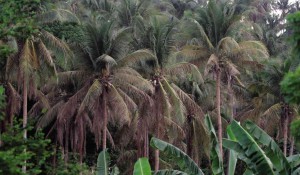Natural enemy of ‘cocolisap’ found
LOS BAÑOS, Laguna—Scientists on Monday announced a breakthrough in the fight against the destructive “cocolisap” with the discovery of a wasp-like native insect as a “natural enemy.”
The presence of Comperiella sp. (Encytidae, Hymenoptera), which is classified as a parasitoid, could naturally end the outbreak of coconut scale insects (CSI), locally referred to as cocolisap, scientists from the University of the Philippines Los Baños (UPLB) and a group of coconut industry stakeholders said in a press conference here.
“Definitely good news for our farmers,” UPLB entomologist Mario Navasero said in a phone interview.
Navasero and his wife Marcela, who is also an entomologist in UPLB, first found the presence of the parasitoid in coconut trees in a farm in San Pablo City, Laguna province, in March.
The parasitoid, described as like a wasp and a relative of bees, punctures the scale of cocolisap and deposits its eggs into the host insect. Its larvae feed on the CSI’s internal tissues until the host dies in a process that takes about 25 days.
Article continues after this advertisementIn the press conference called by nongovernment Save the Coconut Movement (SCM), the Navaseros, along with another UPLB scientist, Dr. Ted Mendoza, announced their findings in what could bring hopes to end the CSI outbreak that has so far affected 2.1 million coconut trees, mostly in Cavite, Laguna, Batangas, Rizal and Quezon provinces.
Article continues after this advertisementCocolisap (Aspidiotus rigidus), which was first detected in Batangas in 2009, causes the leaves of coconut trees to dry up and turn brown before withering away. It is believed to have originated on Sangi Island in Indonesia in the 1920s.
“We’ve been recommending to the PCA (Philippine Coconut Authority) to find these natural enemies but they (PCA officials) were telling us they couldn’t find any,” Navasero said.
In June, President Aquino allotted P70 million for a program to contain CSI. The PCA has approved the injection of neocotinoids into the trunks of infested trees.
According to Navasero, neocotinoids have toxic effects on bees and may disrupt nature’s balance once applied to areas where there is already the presence of the parasitoids.
“There is no more need for neocotinoids, which is basically injecting poison into our source of food. It’s also just a waste of public funds,” said SCM president Rene Pamintuan.
Navasero said the parasitoids must have naturally started growing in number since 2013.
The coconut trees have already grown about 12 green leaves, from just about one to two at the height of the outbreak, he said. A tree grows one leaf per month.
Navasero said more than 80 percent of coconut trees in Batangas and more than 60 percent in Laguna had already shown signs of recovery from the outbreak.
Signs of recovery also indicate that the CSI outbreak is nearing its natural end after five years, he said.
